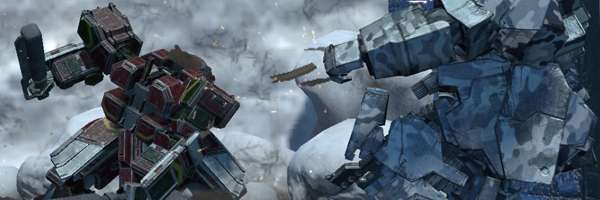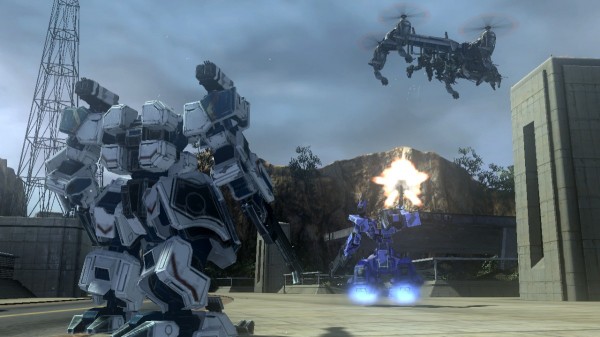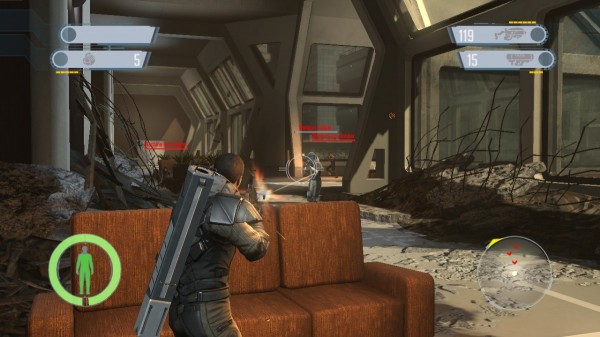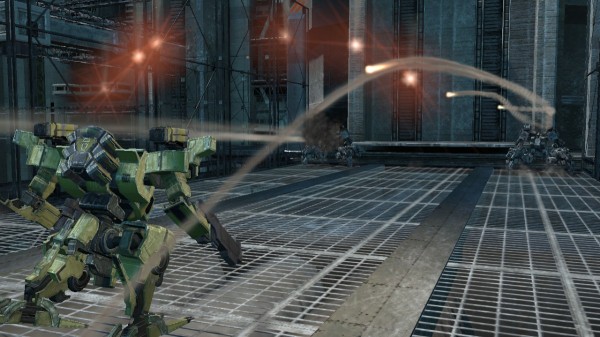Front Mission Evolved PS3 Review

It’s become something of a fad this generation for big-name developers from Japan to outsource their beloved franchises to middle-to-no-name developers from the West, in an attempt to broaden the appeal to both new audiences and despondent fans looking for a change from the same old routine.
Even Square Enix, one of the biggest Japanese game developers around, hasn’t been able to shy away from this. While rumors of a Western-influenced Final Fantasy persist, the company has already taken its first step by outsourcing their tactical robot series, Front Mission, to Double Helix Games; previously responsible for Silent Hill: Homecoming. With another high profile Japanese franchise under their control, can Double Helix make a proper name for themselves? Or will Front Mission’s third-person experiment result in its untimely extinction?
The story of Front Mission Evolved takes place in the year 2171. As the human race advances toward the stars with the creation of orbital elevators, a young engineer named Dylan Ramsey keeps his robotic feet on the ground, working in creating the latest system in Wanzer technology (the name for FM’s iconic mechs). After a sudden terrorist attack on one of the orbital elevators, however, Dylan leaps into the action in an effort to save his father, whose lab is stationed in the center of the chaos. After meeting up with Adela and Russel, two USN Army pilots, Dylan finds himself entangled in a war spanning nations, with the key to victory resting upon the controversial EDGE system his father helped create.
Evolved’s plot is practically a checklist of common RPG tropes; you’ve got the mild-mannered civilian who somehow possesses incredible combat expertise joining forces with a noble faction after his hometown is scorched. You have the obstinate female lead that will inevitably end up as his love interest, the mysterious power that is tied to a tragic past event, and the single-minded villain who craves world domination and/or destruction. It’s a basic story that’s been told many times before, but it’s sufficient enough to keep you engaged despite some hammy moments (see below), but the real stars of Front Mission have always been the hulking, customizable mechs.
While you’ll certainly get your fill of rampaging robots in this game, you might not be too happy about the way they control this time around, especially if you’re a longtime fan. In an effort to “evolve” the series beyond its strategy-based roots, Square chose to let Double Helix transform the mechanics that powered the previous titles into a third-person, free-roaming action shooter. In other words, they appealed to the casual audience that’s responsible for the fifty shooter-related games released every year. Many people criticized this idea the moment it was conceptualized, but in all fairness, it works for the most part.
In almost every mission, you’re in control of your specialized Wanzer, which is capable of equipping four weapons (or three weapons and a shield) at once. Each of the four shoulder buttons corresponds to a Wanzer’s right and left arm, as well as anything mounted on its shoulders. The configuration options can allow you to outfit your war machine with any combination of machine guns, shotguns, melee weapons, and shields for your arms, and mounted rockets, missiles, or grenades for your shoulders. The catch is that you cannot exceed your Wanzer’s weight limit, thereby limiting your crazy creations into something more economical, until you have enough funds to swap out your bot’s limbs and torso for more powerful and more durable replacements. In addition, you can also equip skill slots that will result in random status effects (such as increased accuracy or critical damage).
As fully-featured as Evolved’s customization aspects are, the sad truth is that the move to third-person eliminates any semblance of strategy from a series that once thrived on it. Gone are the moments where players had to think like a war general on the best formations and plans of attack to take down the opposing side, and instead all that’s really required is to keep your robot up-to-date with its hardware, and learn to strafe and shoot around each opponent. The ability to target specific limbs in order to impact enemy machines is retained in this re-imagining (such as damaging its legs to decrease its speed, or its arms to reduce accuracy), but there is little reason to ever do this; nine times out of ten, you’ll want to go for the easier targets (the head and torso), since the goal is to turn your enemy Wanzers into scrap metal. Also, while you can also customize the backpack of your robot, giving it extra boosts in weight management or exclusive abilities (such as an EMP area attack that temporarily stuns other machines), doing so will replace the default Agility pack, which allows your machine to skate-dash around each area. Considering the incredibly slow pace at which your Wanzer moves, you’re pretty much forced to keep the Agility pack equipped at all times, no matter how tempting the additional perks are.
The shooter shoehorning doesn’t stop there though; during some missions, Dylan is required to leave his robot behind and engage other enemies on-foot, which essentially turns the game into a third person cover-based clone. Fortunately, these moments are few and far between, and feature acceptable controls, but are also rather boring due to their simplistic difficulty; most of the time you begin these human-on-human shootouts equipped with a rocket launcher, which takes out anything in its path almost effortlessly. There are also segments where your Wanzer takes control of mounted artillery, usually on a gunship. While there is some simple enjoyment to be had watching enemy fortresses explode in a fireball of gunfire and missiles, these portions also offer little challenge and usually outstay their welcome.
In the graphics department, Front Mission Evolved is something of a middle-point, not as visually impressive as many other titles released this year (including Square’s own Final Fantasy XIII), but sufficient enough to keep it from looking low budget. The game goes for the Michael Bay approach, filling every screen with oodles of explosions, destroyed cities, and so many close-ups of machines and weaponry it almost feels fetishist. Unfortunately, it also decides to copy the “Bayformers” sound effects that plague so many robot-themed titles this generation. The voice actors are competent enough, although main hero Dylan does bear an odd vocal resemblance to Home Movies’ Coach Mcguirk. Even stranger is the exaggerated mouth movements for each character, representing uncanny valley in a nutshell. The one dimensional villains especially like to ham it up in both their mannerisms and line deliveries, which can lead to some amusing situations, even when the story demands you feel the opposite way.
Finally, there are a few technical hiccups that crop up here and there, such as AI enemies and allies either not performing their scripted duties, or just not showing up at all; either outcome will force players to reload their saves, though thankfully checkpoints are frequent and plentiful. Less forgiving are the boss encounters, which are both physically and mentally punishing. The former refers to the absurdly high amounts of life each super-bot carries, resulting in pumping out loads of ammunition, and the latter refers to the way each enemy openly mocks you for your weakness (with their stock dialog repeated ad nauseam over the course of each battle). Simply put, these boss fights are a chore to sit through, especially considering the uselessness of your AI allies (who often serve to block your shots during the more populated skirmishes).
In the end, Front Mission Evolved is not the disaster that many fans feared it to be, delivering an overall decent campaign and customizations for robot junkies to mull over. However, it is also an unnecessary diversion for the series, attempting to increase its mainstream appeal but ultimately having the opposite effect. Rather than trying to imitate more successful shooters, Square Enix would have been better off sticking to the series’ original gameplay. After all, there aren’t a great deal of tactical strategy games available on high-def consoles; it would’ve been nice for Square Enix to have retained Front Mission’s own unique identity instead of forcing it to blend in with the crowd.





